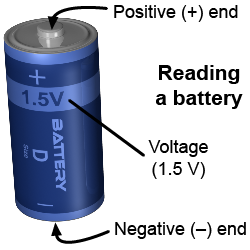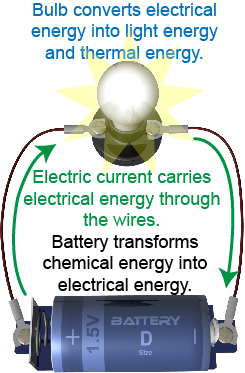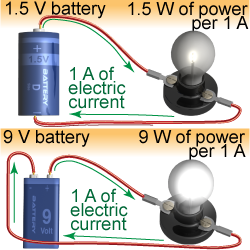|
 If you look carefully at a battery, it will tell you how many volts—an indicator of electrical potential energy—the battery produces. A battery that produces 1 volt (V) provides half the electrical potential energy (per ampere of current) of a battery that produces 2 V. You normally can’t feel the electrical potential energy from ordinary batteries because the energy is too low to push electric current through your skin. You have probably seen lightning, however, which is a spectacular example of high voltage—many millions of volts!—that can send enough electrical energy through your body to kill you.
If you look carefully at a battery, it will tell you how many volts—an indicator of electrical potential energy—the battery produces. A battery that produces 1 volt (V) provides half the electrical potential energy (per ampere of current) of a battery that produces 2 V. You normally can’t feel the electrical potential energy from ordinary batteries because the energy is too low to push electric current through your skin. You have probably seen lightning, however, which is a spectacular example of high voltage—many millions of volts!—that can send enough electrical energy through your body to kill you. 
|
To make potential energy active, something has to move. A falling mass converts its gravitational potential energy into kinetic energy. In electricity, an electric current flows, usually in wires, to carry electrical energy and make it useful. Most electric current is the movement of electrons. One ampere (A) of electric current represents the flow of a large number of electrons per second. 
| 
|
Electric current is invisible, although it is possible to see its effects in cases such as lightning. When you turn on an appliance or a light bulb, electric current transforms electrical potential energy into other forms of energy such as light and thermal energy. If it flows through a motor, electrical energy is transformed into mechanical energy. 
|
Electrical power measures how much electrical energy flows through a circuit per unit time (or per second). Electrical power is greater if the voltage across the circuit is higher (such as with high-voltage power lines) or if there is more electric current through the circuit. Electrical power is the product of electric current and voltage. 
|
| (9.6) | | | P | = | electrical power (W) | | I | = | electric current (A) | | V | = | voltage or potential difference (V) |
| Electrical power
|
|
 Volts and amperes (sometimes called “amps”) are useful because together they determine how much electrical power flows. Voltage is an indication of how much electrical potential energy a circuit has, but it is more useful to think about joules per second (power) instead of energy. If you have 9 V, this means that 1 A of current carries 9 W of power. The wall outlet in your classroom is 120 V, so it delivers 120 W of power per amp of current—a lot of power from a little wire. This is why electricity is so useful!
Volts and amperes (sometimes called “amps”) are useful because together they determine how much electrical power flows. Voltage is an indication of how much electrical potential energy a circuit has, but it is more useful to think about joules per second (power) instead of energy. If you have 9 V, this means that 1 A of current carries 9 W of power. The wall outlet in your classroom is 120 V, so it delivers 120 W of power per amp of current—a lot of power from a little wire. This is why electricity is so useful! 
|
If a lightbulb is connected to a 9 V battery and draws 0.55 A of current, how much power does it use? - 2.25 W
- 5 W
- 13 W
- 36 W
 |
The answer is b, 5 W. Power equals current times voltage, so 9 V times 0.55 A equals 5 W. 
|

